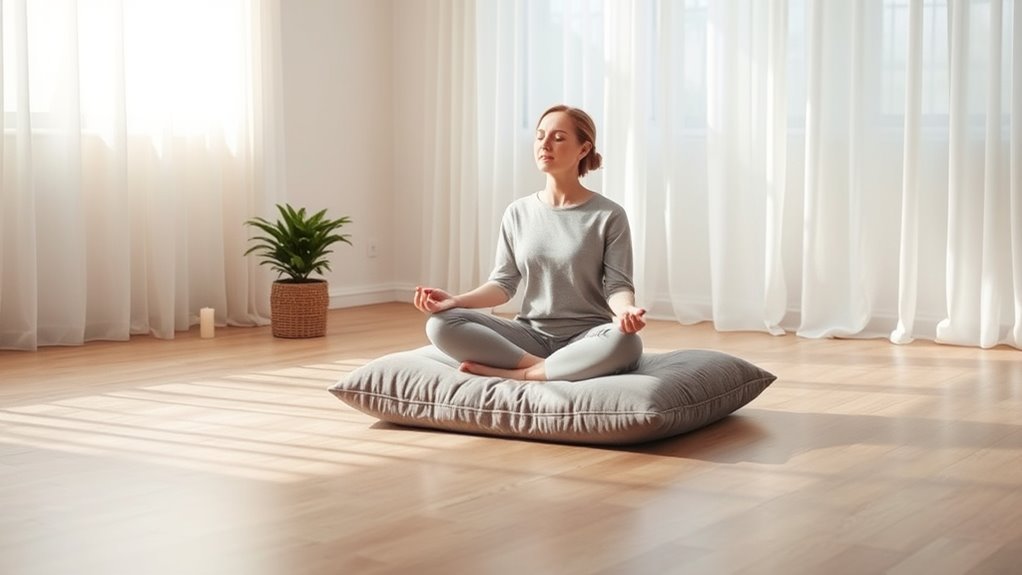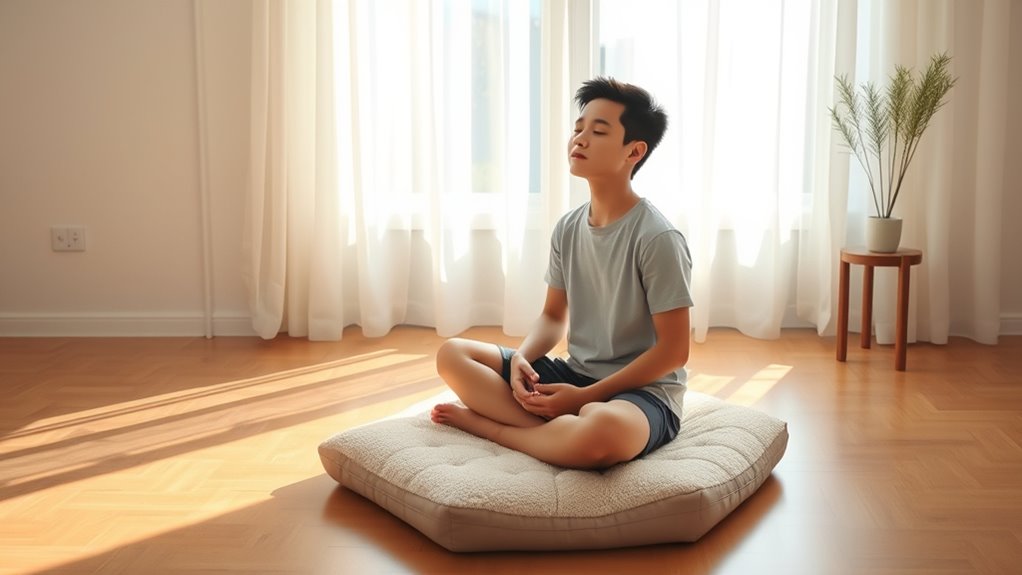To start meditation as an absolute beginner in just three minutes, find a quiet space and sit comfortably with a straight but relaxed posture. Focus on your breath, breathing in slowly through your nose and out through your mouth. Gently observe your thoughts without judgment, and when your mind wanders, softly bring it back to your breath. With consistent practice, you’ll discover more effective techniques to stay calm and centered during even busy days.
Key Takeaways
- Keep the practice simple with focused breathing and relaxed posture to prevent overwhelm for beginners.
- Find a quiet, comfortable space and sit upright to support relaxation and presence.
- Begin with deep breaths, inhaling through the nose and exhaling through the mouth, to anchor your attention.
- Gently acknowledge wandering thoughts and bring focus back to your breath without judgment.
- Practice consistently, even for just three minutes, to build a calming routine and develop mindfulness skills.

Starting meditation can feel overwhelming at first, but anyone can learn how to incorporate it into their daily routine. The key is to keep it simple and approachable. When you’re just beginning, focusing on basic mindfulness practices and relaxation techniques makes the process easier and more effective. These methods help you stay present in the moment and calm your mind, which can be incredibly beneficial for reducing stress and increasing focus. Remember, meditation isn’t about clearing your mind completely; it’s about observing your thoughts without judgment and gently bringing your attention back whenever it wanders.
Starting meditation is simple; focus on mindfulness and relaxation to stay present and reduce stress.
To start, find a quiet space where you won’t be disturbed. Sit comfortably, either on a chair or on the floor, with your back straight but relaxed. Close your eyes if you’re comfortable doing so, or keep a soft gaze directed downward. Begin by taking a few deep breaths, inhaling slowly through your nose and exhaling through your mouth. This sets the tone for relaxation. As you settle in, focus your attention on your breath. Feel the air entering your nostrils, the rise and fall of your chest or belly. This simple breathing exercise is a core relaxation technique that anchors you to the present moment. Incorporating a comfortable seating position can further enhance your posture and overall meditation experience.
Throughout your practice, it’s natural for your mind to wander. When this happens, don’t get frustrated. Gently acknowledge the distraction without judgment and bring your focus back to your breath. This act of returning your attention is a mindfulness practice that strengthens your mental clarity over time. Keep this process gentle and patient. Even a few minutes of focused breathing can create a sense of calm and help you develop a consistent meditation habit.
Frequently Asked Questions
Can Meditation Help With Anxiety or Depression?
Meditation can definitely help with anxiety and depression by strengthening your mindfulness practice. When you meditate regularly, you improve your emotional regulation, making it easier to manage negative thoughts and feelings. Even just a few minutes a day can create positive changes in your mood and stress levels. You might find that meditation helps you stay present, reduces worries, and supports your mental health over time.
What Is the Best Time of Day to Meditate?
The best time of day to meditate varies for everyone, but many find morning routines ideal for mindfulness practices. Starting your day with meditation helps set a calm tone and increases focus. You might prefer early mornings when your mind is fresh, or during breaks in the afternoon. Experiment to discover what fits your schedule, ensuring consistency and making meditation a natural part of your daily routine.
Do I Need Any Special Equipment or Space?
Perfectly practical, you don’t need special equipment or a specific space for meditation. All you require is a peaceful, comfortable spot—your meditation space—that’s free from distractions. As a beginner, focus on creating a cozy corner rather than collecting beginner equipment. A simple cushion or chair can suffice. The key is consistency, not complexity, so choose a space where you feel relaxed and ready to breathe.
How Long Should I Meditate Daily for Benefits?
You should aim for a consistent daily practice of meditation, usually around 10 to 20 minutes, to see noticeable benefits. While even a few minutes can help reduce stress and improve focus, increasing your meditation duration gradually allows you to deepen your experience. The key is regularity—making meditation a daily habit helps your mind adapt and reap the full benefits over time.
Can Meditation Improve My Sleep Quality?
You might worry meditation takes too long to help, but even brief practice boosts sleep quality. By incorporating relaxation techniques into your routine, you improve your sleep hygiene, making it easier to fall asleep and stay asleep. Regular meditation calms your mind, reduces stress, and prepares your body for rest. Just a few minutes daily can make a noticeable difference, helping you wake up feeling refreshed and energized.
Conclusion
Now that you’ve taken your first step into meditation, think of this practice as planting a tiny seed that grows stronger each day. With just three minutes, you’ve opened the door to calmness and clarity. Remember, like a gentle river, your mind will flow and sometimes drift, but each time you return, you’re steering your boat back to peaceful waters. Keep practicing, and watch your inner garden flourish with tranquility.










